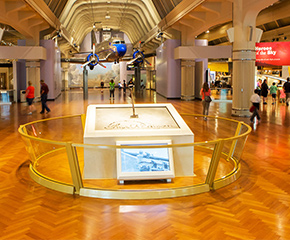Anti-Bilious Purgative Pills, circa 1880
Add to SetSummary
Nineteenth-century entrepreneurs promised cures with patent medicines. Some of these concoctions, however, contained harmful ingredients or ingredients used in unsafe quantities -- the industry was unregulated and manufacturers were secretive about their recipes. Beginning with the Pure Food and Drug Act of 1906, national legislation increasingly prohibited misleading health claims and required manufacturers to list their product's contents.
Nineteenth-century entrepreneurs promised cures with patent medicines. Some of these concoctions, however, contained harmful ingredients or ingredients used in unsafe quantities -- the industry was unregulated and manufacturers were secretive about their recipes. Beginning with the Pure Food and Drug Act of 1906, national legislation increasingly prohibited misleading health claims and required manufacturers to list their product's contents.
Artifact
Patent medicine
Date Made
circa 1880
Creators
Place of Creation
United States, Rhode Island, Providence
Creator Notes
Label indicates that this could be a "Rhodes" product by James A. Rhodes, Providence, Rhode Island.
Location
Not on exhibit to the public.
Object ID
2003.0.16.123
Credit
From the Collections of The Henry Ford.
Material
Paper (Fiber product)
Wax
Color
Yellow
Gold (Color)
Red
Inscriptions
ANTI BILIOUS/PURGATIVE PILLS/AN AUXILIARY TO/RHODES' FEVER & AGUE CURE. [top]
Specifications
Overview: In 2009, The Henry Ford conservation department teamed with Department of Chemistry and Biochemistry, University of Detroit Mercy to analyze a selection of patent medicines in The Henry Ford's collections. The purpose of this analysis was to identify the exact composition of the medicines. Armed with this information, conservators at The Henry Ford will be able to determine appropriate storage methods of the medicines and, in some instances, proper disposal methods for any hazardous materials.
Abstract: A series of patent medicines and nostrums, permanently housed in The Henry Ford in Dearborn, MI, have been analyzed by energy dispersive Xray fluorescence (EDXRF) spectroscopy and multi-nuclear NMR. Such materials were created over a century ago in relative secrecy, and thus the ingredients and recipes have never been made public. The initial findings for metals and organics in these items are presented.
Product Label: Anti Bilious Purgative Pills (laxative)
Possible Ingredients: Byron, Nux Vomica, Bryonia, Lachesis, Lycopodium, Sulphur, Sepia
Form: Pellet
Physical Description: Light yellow/brownish in color. The outer surface has a powder coating. Imperfect spherical shape.
Size (mm): 5.5
Elements Present at 20.0 keV, grouped by Qualitative Peak Size: Big: Mercury (Hg); Very small: Iron (Fe), Palladium (Pb), Calcium (Ca); Detectable: Sulfur (S), Bromine (Br), Potassium (K), Titanium (Ti), Copper (Cu), Chlorine (Cl)
Elements Present at 40.98 keV, grouped by Qualitative Peak Size: Big: Mercury (Hg); Medium: Antimony (Sb); Very small: Palladium (Pb); Detectable: Bromine (Br), Tin (Sn), Iron (Fe), Calcium (Ca)
Method of Analysis: A combination of EDXRF and 1H NMR was used to help determine these compositions. When analyzing for a wide spectrum of elements, a semi-quantitative system was determined. A 1,000 ppm Pb standard was used to compare against peak sizes of the unknowns.
References: The Merck Index an encyclopedia of Chemicals, Drugs, and Biologicals, Tenth edition, Published by Merck and Co., Inc. Rahway, N. J. USA 1983. Wicked Plants by Amy Stewart, Published by Algonquin Books of Chapel Hill, PO Box 2225, Chapel Hill North Carolina 27515. 2009.
Citation: Examination of the Patent Medicines and Nostrums Archived at The Henry Ford via Energy Dispersive Xray Fluorescence and Multi-nuclear NMR. Danielle Garshott (1), Elizabeth McDonald (1), Andrew Diefenbach (1), Thomas Sanday (1), Mary Fahey (2), and Mark A. Benvenuto (1). (1) Department of Chemistry and Biochemistry, University of Detroit Mercy, 4001 W. McNichols Road, Detroit, MI 48221-3038. (2) The Henry Ford, 20900 Oakwood Boulevard, Dearborn, MI 48124-5029.





